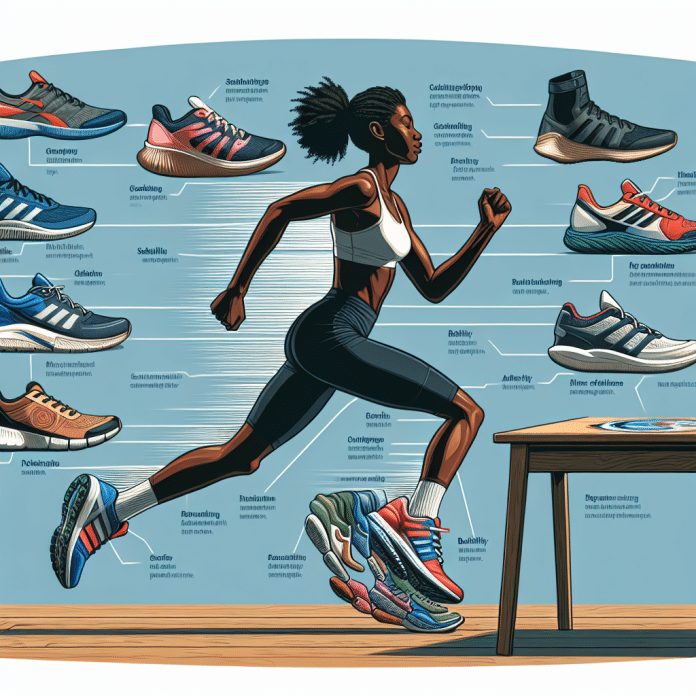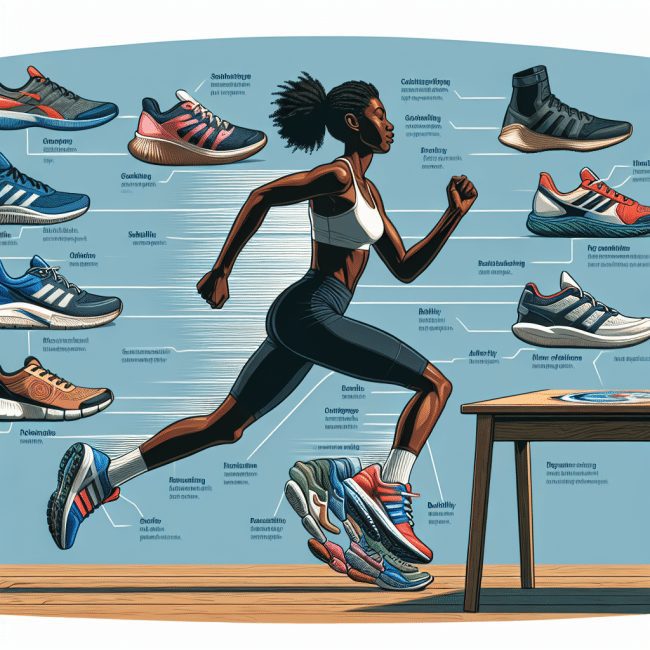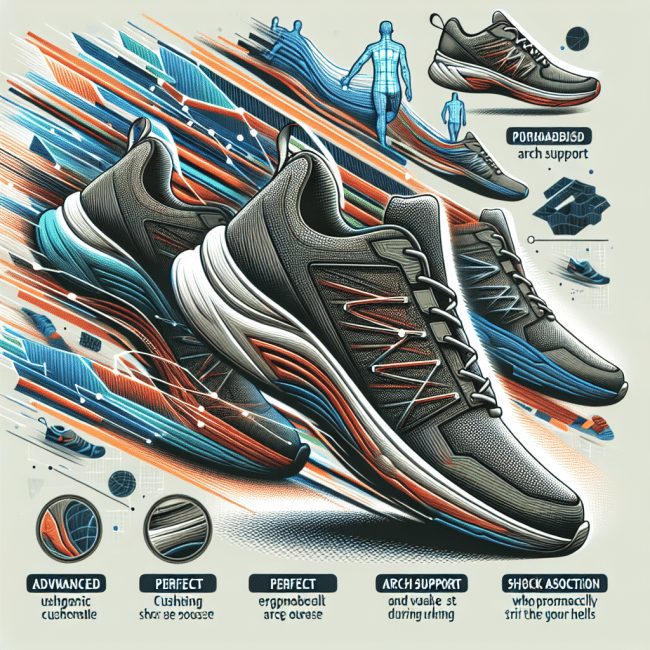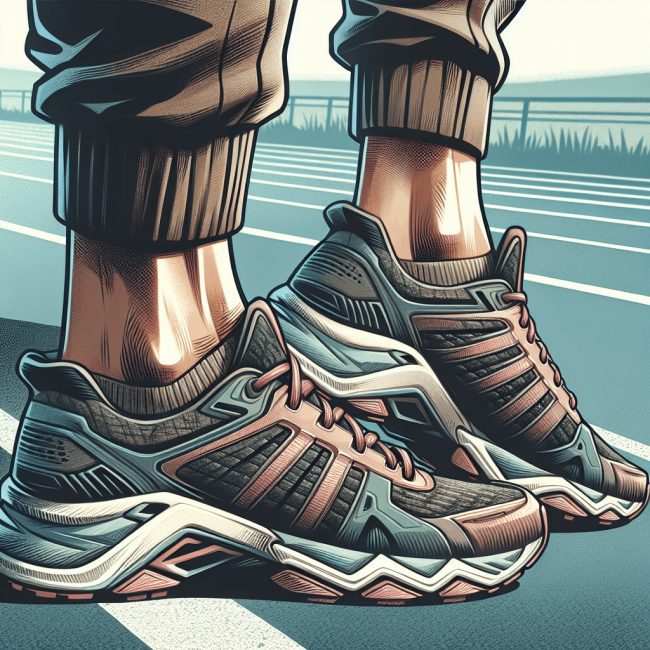So you’re a heel striker, huh? Well, fear not my friend, because in this article we’re going to explore the wonderful world of shoes that cater specifically to your running style. Whether you’re a seasoned runner or just starting out, finding the best shoes for heel strikers can make a world of difference in terms of comfort, support, and injury prevention. From cushioned soles to sturdy arch support, we’ll take a closer look at which shoes are best suited for those who like to lead with their heels. So lace up your sneakers and get ready to embark on a journey to find your perfect pair!
Review contents
Benefits of choosing the right shoes for heel strikers
Reduced risk of injuries
Choosing the right shoes for heel strikers can significantly reduce the risk of injuries. Heel striking, which occurs when your heel strikes the ground first while running or walking, can place excessive strain on the shins, knees, and joints. However, with the proper footwear, the impact can be cushioned and distributed more evenly throughout the foot, reducing the risk of overuse injuries such as stress fractures, shin splints, and plantar fasciitis.
Improved performance
Wearing shoes specifically designed for heel strikers can lead to improved performance. The right shoes can provide the necessary cushioning and support to promote efficient running or walking form, allowing you to maintain a faster pace and extend your endurance. By reducing the impact on your joints and providing optimal shock absorption, these shoes can help you push harder and achieve your fitness goals.
Enhanced comfort
Comfort is a crucial factor when it comes to choosing shoes for heel strikers. The right shoes will provide cushioning that softens the impact when your heel strikes the ground, ensuring a more comfortable running or walking experience. Additionally, these shoes will offer the right amount of arch support, preventing discomfort and reducing the risk of conditions such as arch pain or plantar fasciitis. When your feet are comfortable, you can focus on your activity and enjoy your workouts to the fullest.
Correcting gait abnormalities
Gait abnormalities, such as overpronation or supination, can increase the risk of injuries for heel strikers. Overpronation occurs when the foot rolls inward excessively, while supination refers to an outward rolling motion. The right shoes for heel strikers can correct these gait abnormalities by providing stability and support. Stability shoes, motion control shoes, and orthopedic shoes, for example, are specifically designed to address issues related to overpronation or supination, ensuring a more balanced and aligned gait.
Optimal shock absorption
Shock absorption is a crucial consideration for heel strikers, as the impact of every step is felt primarily in the heel area. The right shoes can absorb the shock effectively, reducing stress on the joints and preventing potential injuries. Cushioned running shoes or maximalist running shoes, for example, are designed with extra padding and support in the heel area to absorb the impact. By choosing shoes that excel in shock absorption, you can run or walk more comfortably and protect your joints from unnecessary strain.
Factors to consider when choosing shoes for heel strikers
When choosing shoes for heel strikers, several factors should be taken into consideration to ensure optimal comfort, support, and performance.
Cushioning
Cushioning is essential for heel strikers as it provides shock absorption and reduces the impact on the feet and joints. Look for shoes that have ample cushioning in the heel area to absorb the shock of each step. Different shoe brands and models offer varying degrees of cushioning, so it’s important to find the right level of cushioning that suits your needs and preferences.
Heel-to-toe drop
Heel-to-toe drop refers to the height difference between the heel and the toe of the shoe. Some heel strikers may benefit from a higher heel-to-toe drop, while others may prefer a lower drop. It’s crucial to find a drop that aligns with your natural running or walking gait to promote proper foot strike and stride.
Flexibility
Consider the flexibility of the shoe when selecting footwear for heel strikers. The shoe should offer a certain degree of flexibility to allow for proper foot movement and natural toe-off during the running or walking motion. Avoid shoes that are overly rigid, as they can restrict your foot’s natural range of motion.
Arch support
Choosing shoes with the right amount of arch support is important for heel strikers, especially those who have high or low arches. Arch support helps distribute body weight evenly across the foot and promotes proper alignment. Look for shoes that offer adequate arch support to prevent discomfort and potential foot conditions related to improper arch support.
Durability
Durability is a key factor in choosing shoes for heel strikers, especially for those who engage in regular running or walking activities. Look for shoes made from high-quality materials that can withstand the repetitive impact of heel striking and provide long-lasting performance.
Fit and size
Getting the right fit and size is crucial when choosing shoes for heel strikers. Ill-fitting shoes can lead to discomfort, blisters, and even injuries. Ensure that the shoes are snug, but not too tight, and provide ample room for your toes. It’s recommended to try on shoes in the afternoon when your feet tend to be slightly swollen, as this can give you a more accurate idea of the fit.
Breathability
Breathability is important to keep your feet cool and dry during physical activities. Look for shoes made with breathable materials that allow air to circulate and prevent excessive moisture buildup, reducing the risk of blisters and fungal infections.
Weight
Consider the weight of the shoes when choosing footwear for heel strikers. Lightweight shoes can provide a more responsive and agile feel, allowing for quicker foot movements. However, it’s important to strike a balance between weight and cushioning to ensure adequate shock absorption.
Traction
Traction is essential for heel strikers who often run or walk on various surfaces. Look for shoes with a sturdy and durable outsole that offers good traction to prevent slipping and provide stability, particularly on uneven or slippery terrain.
Price
Price is always a factor to consider when choosing shoes, but it shouldn’t be the sole determining factor. Quality shoes may come at a higher price, but they offer better durability, support, and comfort, making them a worthwhile investment in your foot health and overall performance.
Types of shoes recommended for heel strikers
There is a wide range of shoe types available that are suitable for heel strikers. Each type offers different features and benefits, so it’s important to choose the one that best suits your needs and preferences.
Cushioned running shoes
Cushioned running shoes are specifically designed to provide maximum shock absorption and comfort. These shoes have extra padding and cushioning in the heel area, making them ideal for heel strikers who prioritize cushioning and want to reduce the impact on their joints.
Stability running shoes
Stability running shoes are designed for runners who overpronate, meaning their feet roll inward excessively during the running gait. These shoes offer additional support and stability through features such as a medial post or a firmer midsole to help correct the foot’s pronation and promote a more neutral foot strike.
Motion control running shoes
Motion control running shoes are recommended for severe overpronators who need extra stability and control to prevent excessive inward rolling of the feet. These shoes often feature a reinforced structure, such as a rigid arch support, to provide maximum support and limit overpronation.
Maximalist running shoes
Maximalist running shoes are known for their thick and plush cushioning throughout the midsole. These shoes offer excellent shock absorption and are suitable for heel strikers who prioritize cushioning and comfort.
Neutral running shoes
Neutral running shoes are designed for runners with a more neutral foot strike who do not require additional support for pronation or supination. These shoes generally have a more balanced cushioning and provide a good combination of comfort and flexibility.
Walking shoes
Walking shoes, both for exercise and everyday use, are designed to provide cushioning and support specifically for walking form. These shoes are generally more flexible than running shoes and provide a comfortable and supportive walking experience for heel strikers.
Trail running shoes
Trail running shoes are designed for running on off-road terrains such as dirt trails, rocky paths, or muddy surfaces. These shoes provide enhanced traction, stability, and protection to allow heel strikers to run confidently on various uneven surfaces.
Cross-training shoes
Cross-training shoes are versatile shoes suitable for a variety of activities, including running, strength training, and high-impact workouts. These shoes offer a combination of cushioning, stability, and flexibility, making them suitable for heel strikers who engage in different types of exercises.
Minimalist shoes
Minimalist shoes, also known as barefoot shoes, provide minimal cushioning and support to simulate a barefoot running experience. These shoes encourage a more natural foot strike and can be suitable for heel strikers looking to gradually transition to a different running form.
Orthopedic shoes
Orthopedic shoes are specifically designed to address foot-related conditions and provide optimal support and stability. These shoes are often recommended for individuals with foot abnormalities or special requirements, such as custom orthotics.
Top shoe brands for heel strikers
While there are numerous shoe brands available, some brands have proven to consistently provide high-quality footwear for heel strikers. These brands offer a wide range of options to cater to different foot types, preferences, and running styles.
Nike
Nike is a renowned sports brand that offers a wide selection of running shoes suitable for heel strikers. Known for their innovative designs and cutting-edge technology, Nike shoes provide excellent cushioning, support, and durability.
Adidas
Adidas is another popular brand that produces running shoes suitable for heel strikers. Adidas shoes are known for their combination of performance, style, and comfort. Their running shoes offer a balance of cushioning and stability to cater to different running needs.
Brooks
Brooks specializes in running shoes and is recognized for its focus on providing footwear designed specifically for runners. Brooks shoes offer excellent cushioning and support, making them a great choice for heel strikers.
New Balance
New Balance is a brand that caters to a wide variety of foot types and offers shoes in various widths. They prioritize comfort and performance, producing running shoes that provide excellent cushioning and stability for heel strikers.
Saucony
Saucony is known for its commitment to producing high-quality running shoes that cater to different types of runners. Their shoes offer a good balance of cushioning, support, and flexibility for heel strikers.
ASICS
ASICS is a brand that emphasizes comfort, support, and durability in their running shoes. Their shoes incorporate advanced technology and cushioning systems to provide optimal shock absorption for heel strikers.
Hoka One One
Hoka One One is a brand that stands out for its maximalist running shoes. These shoes provide maximum cushioning and shock absorption, making them a great option for heel strikers who prioritize comfort and protection.
Mizuno
Mizuno is a brand known for its attention to detail and quality craftsmanship. Their running shoes offer a combination of cushioning and stability, providing a comfortable and supportive experience for heel strikers.
Salomon
Salomon specializes in trail running shoes and is renowned for its durable and well-constructed footwear. Their trail running shoes provide excellent traction and stability for heel strikers who enjoy running off-road.
Altra
Altra is a brand that focuses on producing running shoes with a spacious toe box and zero-drop platform. Their shoes are known for their natural foot shape design and can be suitable for heel strikers looking for a more minimalist approach.
How to find the right shoes for your individual needs
Finding the right shoes for your individual needs as a heel striker involves several key steps and considerations. By following these guidelines, you can ensure a proper fit and select shoes that suit your running or walking style.
Get your feet analyzed
Start by getting your feet analyzed professionally. Visit a specialty running store or a professional shoe fitter who can assess your foot size, arch type, and gait. This analysis will provide valuable insight into your specific foot needs and guide you in choosing the most appropriate shoes.
Consider your running style
Consider your running or walking style when selecting shoes. Do you have a heavy heel strike, or do you transition to a midfoot or forefoot strike? Understanding your running style can help determine the level of cushioning, stability, and support you require in your shoes.
Check for pronation
Identify whether you overpronate, supinate, or have a neutral foot strike. Overpronators tend to benefit from stability shoes or motion control shoes, while supinators may require shoes with extra cushioning and flexibility. Neutral foot strikers can opt for neutral running shoes.
Understand your arch type
Determine your arch type, whether it’s high, low, or neutral. Different shoes offer varying levels of arch support, so it’s important to choose shoes that cater to your specific arch needs.
Assess cushioning and stability needs
Consider how much cushioning and stability you require. If you have a heavy heel strike or prefer ample cushioning, shoes with extra padding or maximalist shoes may be suitable. On the other hand, if you have a more balanced foot strike, shoes with moderate cushioning and stability should suffice.
Try different shoe models
Try on different shoe models to find the ones that offer the best fit and comfort for you. Walk or run in the shoes within the store to assess how they feel and support your feet. Pay attention to any discomfort, pressure points, or lack of support.
Consider personal preferences
Take your personal preferences into account when selecting shoes. Do you prefer a certain brand, style, or color? While comfort and functionality are paramount, enjoying your shoes and feeling confident in your choice can contribute to a more positive running experience.
Seek professional advice
If you’re unsure about choosing the right shoes for your individual needs, seek professional advice from a podiatrist, sports medicine specialist, or running coach. They can offer specialized guidance tailored to your specific foot biomechanics and running goals.
Read reviews and customer feedback
Read reviews and customer feedback about the shoes you’re considering. These reviews can provide valuable insights into the comfort, durability, and performance of the shoes from real users. Look for reviews from individuals who have similar foot characteristics and running styles as you.
Do a test run
Once you’ve selected a pair of shoes that meets your needs on paper, take them for a test run. This will allow you to assess how the shoes feel in action and determine if they provide the desired level of comfort, support, and performance. Pay attention to any discomfort or issues that arise during the run.
Common mistakes to avoid when choosing shoes for heel strikers
When choosing shoes for heel strikers, it’s important to avoid common mistakes that can compromise comfort, support, and performance. By being aware of these mistakes, you can make informed decisions that prioritize your foot health and running experience.
Ignoring individual biomechanics
Ignoring individual biomechanics is a common mistake when selecting shoes. Each person has unique foot characteristics and running styles, and these should be taken into account when choosing footwear. Understanding your foot strike, pronation, and arch type can help you select shoes that provide the necessary support and alignment.
Prioritizing style over functionality
While style is important to many people, prioritizing it over functionality when selecting running shoes can lead to discomfort and potential injuries. Ensure that the shoes you choose provide the necessary cushioning, support, and stability rather than solely focusing on their aesthetic appeal.
Selecting shoes based on brand popularity
Choosing running shoes solely based on brand popularity can be a mistake. While reputable brands often produce high-quality footwear, they may not offer the specific features and support required for heel strikers. Focus on finding shoes that align with your individual needs rather than solely relying on brand recognition.
Failing to replace worn-out shoes
Continuing to wear worn-out shoes can lead to reduced support, cushioning, and stability. Make sure to replace your running shoes regularly, as worn-out shoes can increase the risk of injuries and compromise your running performance.
Buying shoes that are too narrow or tight
Choosing shoes that are too narrow or tight can cause discomfort, blisters, and potential foot issues. Ensure that the shoes you choose provide ample room for your toes to move and that they fit comfortably without being too restrictive.
Neglecting the importance of flexibility
Flexible shoes allow for a more natural range of motion and promote proper foot strike. Neglecting flexibility when choosing shoes can limit foot movement and potentially lead to discomfort or altered running form.
Not considering terrain specificity
Consider the specific terrain on which you’ll be running or walking. Different shoes are designed for different terrains, and choosing shoes that aren’t suitable for the surfaces you’ll encounter can affect your traction, stability, and overall performance.
Overlooking the importance of arch support
Arch support plays a crucial role in maintaining proper foot alignment and preventing discomfort or foot conditions. Overlooking the importance of arch support can lead to issues such as plantar fasciitis or arch pain. Make sure to choose shoes that offer the appropriate level of arch support for your foot type.
Disregarding weight and breathability
The weight and breathability of running shoes can significantly impact your comfort and performance. Disregarding these factors can lead to sweaty and uncomfortable feet, as well as hindered movement due to excessive shoe weight. Consider shoes that provide adequate breathability and are lightweight to optimize your running experience.
Ignoring personal comfort
Ultimately, personal comfort is paramount when choosing shoes for heel strikers. If a shoe doesn’t feel right or doesn’t provide the desired level of cushioning and support, it may not be the best choice for you. Trust your instincts and prioritize your comfort above all else.
Additional factors to optimize heel strike running
Optimizing your heel strike running goes beyond choosing the right shoes. Considering these additional factors can help you improve your performance, reduce the risk of injuries, and enhance your overall running experience.
Proper running form
Focus on maintaining proper running form. Ensure that you have an aligned posture, relaxed arm swing, and a midfoot or forefoot strike when possible. Good running form can minimize the impact on your heels and improve overall efficiency.
Strength training for muscles and tendons
Incorporate strength training exercises into your fitness routine to strengthen the muscles and tendons in your feet, ankles, and lower legs. This can provide additional support and stability while reducing the risk of overuse injuries.
Gradual transition to forefoot or midfoot striking
If you’re interested in transitioning from heel striking to a different foot strike pattern, consider a gradual transition. Forefoot or midfoot striking can distribute the impact more evenly throughout the foot and reduce the strain on your heels and joints. However, it’s important to make this transition gradually to allow your body to adapt and avoid overloading new muscles and tendons.
Importance of stretching and warm-up exercises
Prioritize stretching and warm-up exercises before your running or walking sessions. This can help prepare your muscles and joints for the activity, improve flexibility, and reduce the risk of injuries.
Rest and recovery
Allow for adequate rest and recovery between your running sessions. Rest days are essential for your body to repair and adapt to the demands of running, reducing the risk of overuse injuries.
Monitoring training volume and intensity
Be mindful of your training volume and intensity. Gradually increase mileage and intensity to avoid overloading your body and prevent injuries. Listen to your body and adjust your training accordingly.
Listen to your body
Pay attention to any discomfort, pain, or changes in your body. If something doesn’t feel right, take a break, seek professional advice, and make the necessary adjustments to prevent further complications.
Consult a running coach or physical therapist
Consider consulting a running coach or physical therapist for personalized guidance. These professionals can provide expert advice on running form, training programs, and injury prevention strategies specific to your needs as a heel striker.
Consider orthotics or insoles
Orthotics or insoles can provide additional support and help correct biomechanical issues. If you have specific foot abnormalities or require additional support, consult with a podiatrist or orthopedic specialist to determine if orthotics or insoles are necessary.
Benefit of cross-training
Incorporate cross-training into your routine to strengthen different muscle groups, improve overall fitness, and reduce the risk of overuse injuries. Activities such as swimming, cycling, or strength training can complement your running efforts and provide a well-rounded fitness routine.
Conclusion
Choosing the right shoes for heel strikers is essential for reducing the risk of injuries, improving performance, and ensuring optimal comfort. Factors such as cushioning, heel-to-toe drop, arch support, flexibility, and fit should be considered when selecting footwear. Various shoe types, including cushioned running shoes, stability running shoes, and motion control running shoes, cater to the specific needs of heel strikers. Top shoe brands like Nike, Adidas, and Brooks offer a wide range of options to choose from.
To find the right shoes for your individual needs, it’s important to get your feet analyzed, consider your running style, and assess your pronation and arch type. Trying different shoe models, considering personal preferences, and seeking professional advice are also crucial steps in the shoe selection process.
Avoiding common mistakes such as ignoring individual biomechanics, prioritizing style over functionality, and failing to replace worn-out shoes is important for maintaining foot health as a heel striker. Optimizing heel strike running involves focusing on proper running form, incorporating strength training, considering a gradual transition to forefoot or midfoot striking, and prioritizing stretching and rest days.
By following these guidelines and considering the key factors and mistakes to avoid, you can make informed decisions when choosing shoes for heel strikers. Remember to prioritize comfort, support, and individual needs to optimize your running experience and reduce the risk of injuries.











